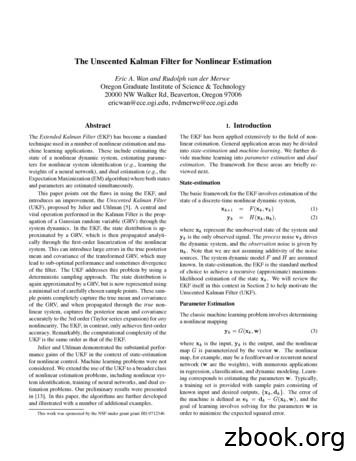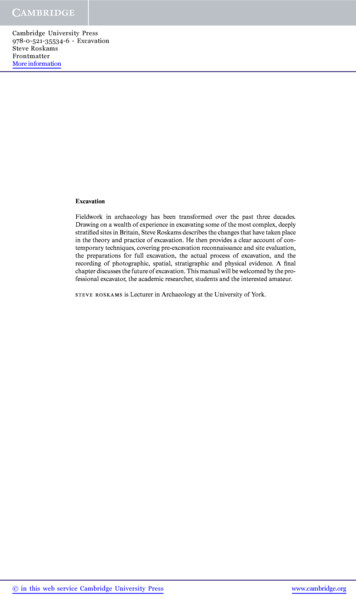Tied Survival Times; Estimation Of Survival Probabilities
Tied survival timesEstimating survival probabilitiesTied survival times; estimation of survivalprobabilitiesPatrick BrehenyNovember 5Patrick BrehenySurvival Data Analysis (BIOS 7210)1/22
Tied survival timesEstimating survival probabilitiesIntroductionBreslow approximationEfron approximationDiscrete modelIntroductionThus far, we have worked with Cox regression under theassumption that no ties are present among the failure times,and thus, that the data can be uniquely sorted with respect totimeIn many data sets, however, ties are present, usually due tothe fact that failure times are only reported to the nearest dayOur first topic for today is how to handle tied survival times inthe Cox regression modelPatrick BrehenySurvival Data Analysis (BIOS 7210)2/22
Tied survival timesEstimating survival probabilitiesIntroductionBreslow approximationEfron approximationDiscrete modelAverage partial likelihoodPerhaps the most natural solution would be to consider allpossible ways of breaking the ties as equally likelyIn this approach, the Cox partial likelihood would be replacedwith the average of the Cox partial likelihoods over all theorderings in which the ties have been brokenAs a simple example, suppose subjects 2 and 3 fail at a giventime, and that subject 4 is also in the risk set at that time;the likelihood contribution would be1ww1wwP 2P 3 P 3P 22 2,3,4 wj 3,4 wj2 2,3,4 wj 2,4 wjPatrick BrehenySurvival Data Analysis (BIOS 7210)3/22
Tied survival timesEstimating survival probabilitiesIntroductionBreslow approximationEfron approximationDiscrete modelBreslow approximation: IdeaThe averaging method is intuitively reasonable, but from amathematical and computational standpoint, very messy andtime-consuming to work withAn approximation that greatly simplifies the resultingcalculations was proposed by Breslow (1974)To continue our simple example from the previous slide, theidea is that X 2XXXXwjwj wjwj wj2,3,43,42,3,4Patrick Breheny2,42,3,4Survival Data Analysis (BIOS 7210)4/22
IntroductionBreslow approximationEfron approximationDiscrete modelTied survival timesEstimating survival probabilitiesBreslow approximation: FormulaPLetting sj i Dj xi denote the sum of the covariates overthe set Dj of subjects who fail at time j, applying the Breslowapproximation yields the likelihoodL(β) JYj 1exp(sTj β){Pk Rjexp(xTk β)}djThe obvious advantage of this approximation is that theresulting likelihood looks almost exactly like the original Coxlikelihood, and results in very minor modifications to thescore, information, and algorithm that we derived last weekPatrick BrehenySurvival Data Analysis (BIOS 7210)5/22
Tied survival timesEstimating survival probabilitiesIntroductionBreslow approximationEfron approximationDiscrete modelEfron approximation: MotivationAn alternative approximation was proposed by Efron (1977)Clearly, there is an advantage to common denominators in thesum on slide 3, as it allows us to combine the sum into asingle termIt is also clear, however, that the denominator in the Breslowapproximation is always larger than it should bePatrick BrehenySurvival Data Analysis (BIOS 7210)6/22
IntroductionBreslow approximationEfron approximationDiscrete modelTied survival timesEstimating survival probabilitiesEfron formulaAs a compromise between the two, Efron suggested using theaverage weightamong the failures at time j,Pw̄ d 1k Dj wk :jX2,3,4wjXwj 3,4Xwj2,3,4X2,4wj Xwj2,3,4 Xwj w̄ 2,3,4In general, then, the likelihood becomesL(β) JYexp(sTj β)j 1Qdj 1 PTr 0 { k Rj exp(xk β) r w̄}Patrick BrehenySurvival Data Analysis (BIOS 7210)7/22
Tied survival timesEstimating survival probabilitiesIntroductionBreslow approximationEfron approximationDiscrete modelRemarksTo summarize:Average partial likelihood: Best accuracy, hardest to work withEfron approximation: Good accuracy, moderately easy to workwithBreslow approximation: Least accurate, very easy to work withWhen the number of ties is small, there is typically littledifference between the approachesMany software programs implement the Breslow approach forits simplicity, but the survival package uses the EfronapproximationPatrick BrehenySurvival Data Analysis (BIOS 7210)8/22
Tied survival timesEstimating survival probabilitiesIntroductionBreslow approximationEfron approximationDiscrete modelDiscrete Cox modelHowever, what if there are a lot of ties?In that case, it would make sense to treat the failuredistribution as discrete, and propose a model in terms of thediscrete hazards λij (the hazard for the ith subject at time j)as opposed to the hazard density λi (t)The semiparametric analog to Cox regression in the discretecase isλijλ0j exp(xTi β)1 λij1 λ0jPatrick BrehenySurvival Data Analysis (BIOS 7210)9/22
Tied survival timesEstimating survival probabilitiesIntroductionBreslow approximationEfron approximationDiscrete modelConditional logistic regressionBy conditioning on the number of failures at each time j, onecan construct a likelihood for β that is free of intercept terms,allowing us to avoid specifying λj0This model, which is also widely used in categorical dataanalysis, is known as conditional logistic regression, and is alsoreferred to as the “discrete Cox model” in survival analysisThis model is available in coxph through the ties ‘exact’optionPatrick BrehenySurvival Data Analysis (BIOS 7210)10/22
Tied survival timesEstimating survival probabilitiesDerivationExamplesMotivationAs we have remarked several times, the Cox model is a modelonly for the relative risk comparing subjects versus each other– it makes no predictions as far as absolute riskIn other words, we can use the Cox model to estimatecoefficients, hazard ratios, etc., but we cannot use it toestimate the probability, say, that a subject will survive atleast 2 yearsSuch quantities are clearly of interest in many applications,however; is there a way we can go back and estimate abaseline hazard?Patrick BrehenySurvival Data Analysis (BIOS 7210)11/22
Tied survival timesEstimating survival probabilitiesDerivationExamplesBasic approachIt is certainly possible to write down the nonparametriclikelihood under proportional hazards and consider the jointmaximum likelihood estimation of β and the point masses λ0jat each observed failure timeMore simply, however, we can just fix β at the Cox regressionb then maximize the likelihood with respect to theestimate β,λ0j parameters aloneTypically, there is little difference between the approaches, asthe point masses themselves tend to have little impact on therelative risksPatrick BrehenySurvival Data Analysis (BIOS 7210)12/22
Tied survival timesEstimating survival probabilitiesDerivationExamplesNonparametric likelihoodIn our lecture on the Kaplan-Meier estimate, we showed thatthe nonparametric MLE of the survival function S(t) is adiscrete function with point masses at the observed failuretimes (and no mass anywhere else)Making the appropriate modifications to allow eachobservation its own subject-specific hazard, we have:oYn YYL(λ) λij(1 λij ) ,ji Dji Rj Djwhere j indexes failure times, with Dj the set of individualsdying at time j and Rj is the risk setPatrick BrehenySurvival Data Analysis (BIOS 7210)13/22
Tied survival timesEstimating survival probabilitiesDerivationExamplesProportional hazards on the discrete scaleThe proportional hazards assumption implies the followingrelationship between subject-specific survival and baselinesurvival:Si (t) S0 (t)wi ,where wi exp(xTi β)QSince S(t) tj t (1 λj ) for a discrete survival function,this means thatλij 1 (1 λ0j )wiPatrick BrehenySurvival Data Analysis (BIOS 7210)14/22
Tied survival timesEstimating survival probabilitiesDerivationExamplesMain resultLetting αj 1 λ0j , the nonparametric MLE of S0 given βcan be represented withoYn YYL(α) (1 αjwi )αjwi ,ji Dji Rj DjIn the case where only one failure occurs at tj , we haveα̂j (1 πjj )1/wj ;if more than one failure occurs, there is no closed formsolution and numerical optimization methods must be used tosolve for α̂jPatrick BrehenySurvival Data Analysis (BIOS 7210)15/22
Tied survival timesEstimating survival probabilitiesDerivationExamplesSurvival formulasOnce we have obtained βb and α̂, our estimates of the survivalfunction for a subject with covariate values xi is given byŜi (t) Ybexp(xTi β)α̂j,tj twhich, like the Kaplan-Meier estimate, will be a step function withdiscontinuous drops at every observed failure timePatrick BrehenySurvival Data Analysis (BIOS 7210)16/22
Tied survival timesEstimating survival probabilitiesDerivationExamplessurvfit.coxphThe survfit function from the survival package can beapplied to the output of a Cox regression model in order tocarry out estimation of the baseline hazard as described onthe previous slides:fit - coxph(S trt stage hepato bili, pbc)sfit - survfit(fit)The methods we described previously, such as summary(sfit)and plot(sfit), work exactly as they did beforeThe survival package also calculates a confidence intervalfor Ŝi (t), although in the interest of time, we won’t go intothe detailsPatrick BrehenySurvival Data Analysis (BIOS 7210)17/22
Tied survival timesEstimating survival probabilitiesDerivationExamplesPBC example (baseline)Progression free survival1.00.80.60.40.20.0024681012Time (years)By default, the curve is drawn at x 0 for the centered model;i.e., at the mean of each covariatePatrick BrehenySurvival Data Analysis (BIOS 7210)18/22
Tied survival timesEstimating survival probabilitiesDerivationExamplesSubject specific curvesLike predict, survfit.coxph accepts a newdata argument,allowing the calculation of subject-specific survival curvesndat - data.frame(trt 0, stage 1:4, hepato 0, bili 1)sfit - survfit(fit, newdata ndat)One can then submit plot(sfit) to plot the curves or printsfit, which will provide estimates and confidence intervals forthe median survival timePatrick BrehenySurvival Data Analysis (BIOS 7210)19/22
Tied survival timesEstimating survival probabilitiesDerivationExamplesPBC example: Survival by stageStage: 1Stage: 2Stage: 3Stage: 4Progression free survival1.00.80.60.40.20.0024681012Time (years)Patrick BrehenySurvival Data Analysis (BIOS 7210)20/22
Tied survival timesEstimating survival probabilitiesDerivationExamplesGVHD example: Cox versus Kaplan-MeierMTXMTX CSPProgression free survival1.00.80.60.40.20.00102030405060Time (days)Patrick BrehenySurvival Data Analysis (BIOS 7210)21/22
Tied survival timesEstimating survival probabilitiesDerivationExamplesRemarksAlthough the approaches are similar, it is important to keep inmind that survival function estimation in the Cox model isrestricted to obey the proportional hazards assumption, andtherefore cannot capture non-proportional aspects of the dataFor example, in the GVHD data, there appears to be littledifference between the treatment groups at early times and amore substantial difference at later times; by construction, theCox estimates show a constant benefit over timeIn later lectures, we will discuss diagnostics and potentialremedies for non-proportional hazardsPatrick BrehenySurvival Data Analysis (BIOS 7210)22/22
Tied survival times Estimating survival probabilities Introduction Breslow approximation Efron approximation Discrete model Breslow approximation: Idea The averaging method is intuitively reasonable, but from a mathematical and computational standpoint, very messy and time-consuming to work w
Practice basic survival skills during all training programs and exercises. Survival training reduces fear of the unknown and gives you self-confidence. It teaches you to live by your wits. Page 7 of 277. FM 21-76 US ARMY SURVIVAL MANUAL PATTERN FOR SURVIVAL Develop a survival pattern that lets you beat the enemies of survival. .
survival guide book, zombie apocalypse survival guide government, zombie apocalypse survival guide essay, zombie apocalypse survival guide movie, zombie apocalypse survival guide apk, zombie apocalypse survival guide video meetspaceVR the home to the UK's greatest free-roam virtual reality experiences in London, Nottingham and Birmingham. Oct .
Hegemony or Survival: America's Quest for Global Dominance by Noam Chomsky Research Notes NOTES TO CHAPTER 1 1 . November 2002, sec. A, p. 1. Andrew Card cited in Doug Saunders, with reports from Associated Press New York Times,,. Hegemony or Survival., American Empire, Hegemony or Survival Hegemony or Survival. , New York , . 2 . Deterring .
Introduction to Survival Analysis 4 2. The Nature of Survival Data: Censoring I Survival-time data have two important special characteristics: (a) Survival times are non-negative, and consequently are usually positively skewed. – This makes the na
A spreadsheet template for Three Point Estimation is available together with a Worked Example illustrating how the template is used in practice. Estimation Technique 2 - Base and Contingency Estimation Base and Contingency is an alternative estimation technique to Three Point Estimation. It is less
Introduction The EKF has been applied extensively to the field of non-linear estimation. General applicationareasmaybe divided into state-estimation and machine learning. We further di-vide machine learning into parameter estimation and dual estimation. The framework for these areas are briefly re-viewed next. State-estimation
Shibori is a Japanese technique in which fabric is tightly tied in various patterns and then dyed so that the places, which are tied, form a resist to the dye and do not take up dye. By arranging . Arashi Shibori- tied round a pole Shibori - tied round small objects Shibori - clamped.
Cambridge Manuals in Archaeology is a series of reference handbooks designe fodr an international audience of upper-level undergraduate and graduate students and , professional archaeologist ands archaeologica l scientist isn universities, museums, research laboratorie and fields units. Each book include a surve oysf current archaeological practice alongside essential referenc on contemporare .























